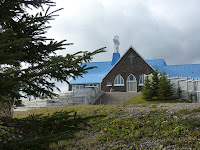Part of it was a recap. There was a longing to go back to where we had begun, so many weeks ago now. Back to the Bay of Fundy. Back to historic Saint John, where the St John River rushes into the sea only to reverse with the tides. Back to Grannon's, where we had eaten our first and second- best seafood chowder! (The best was on the wharf at Shediac, NB, not far from Moncton.) Back to the charm of history-lined streets we had explored with our first volunteer cohort.
 |
| Bonnie Isaak, Lila and Ron King along with a very happy proprietor |
We spent the night with the Earl of Leinster (an old renovated B&B!) and bright and early the next morning began our explorations of Fundy Coast west. We found the coastline more rolling, compared to the rising cliffs and flowerpot rocks north of Saint John ( eg Hopewell Rocks) and many of the little fishing villages appeared somewhat depressed.
 |
| we are very close to the American border here |
There are many exciting coastal islands to explore, but we had to content ourselves with just one. A 20 minute free ferry ride on the John E. Rigby brought us to Deer Island (population 1000 souls); inhabited by Europeans since 1770.
 |
| the ferry barge pulled and pushed by a tug |
Fishing is still the the primary industry here.
We were interested in some of the fishing techniques that were apparent. Herring weirs, sardines for canneries, Atlantic salmon "raised, harvested and dressed", lobster pounds where lobster are kept (up to 3 million) until markets are right...all prominent on this island. Deer Island has the first Atlantic Canada sea farm.
 |
| "aqua culture"/salmon farming in circle to right |
We were interested in some of the fishing techniques that were apparent. Herring weirs, sardines for canneries, Atlantic salmon "raised, harvested and dressed", lobster pounds where lobster are kept (up to 3 million) until markets are right...all prominent on this island. Deer Island has the first Atlantic Canada sea farm.
 |
| herring weir |
 |
| lobster pound on dock to right |
 |
| colourful tangle of fishing gear |
From Deer Island we drove to St. Andrews-By-The-Sea, touted as New Brunswick's premier vacation destination. We soon saw why. This delightful town, situated on the tip of a little peninsula jutting into the sea, has many attractions including the historic 1889 seaside resort, now the Fairmont Algonquin.
This hotel, built in classic Tudor style by wealthy businessmen from Boston, along with other historic buildings, displays the early United Empire Loyalist history of St. Andrews...another fascinating historical chapter in the Maritimes. Minister's Island, a small island accessible by car from St. Andrews, but only when the tides are out, boasts the magnificent former summer home of Sir. William Van Horne. He is famous for pounding in the last spike of the CPR in BC. We managed to get our car across the rocky sea-bed, only to find that access to the island had been closed off for the season. We hurried back!
We hated to leave this picturesque location but were also eager to visit St. Stephen, the most westerly town on the Fundy Coastal Drive. St. Stephen is home of Ganong Bros Ltd., Canada's oldest candy company with its famous Chocolate Museum. Well, we hadn't considered that this was Sunday, and so we could only wander hungrily around the huge factory (reminiscent of Willie Wonka and The Chocolate Factory, for those of you in the know) and then head to the local SuperStore to buy our ration of this famous chocolate.
Last weekend, as we drove our truck southward to our sale at Enfield, Nova Scotia... well, it could have been Manitoba!
On December 3 we reload our truck for the very last time and after assisting with the closing down of the whole operation at the Petitcodiac warehouse for a week, we will turn our car away from the Atlantic Provinces and head toward our prairie home. Looking forward to seeing many of you!
























